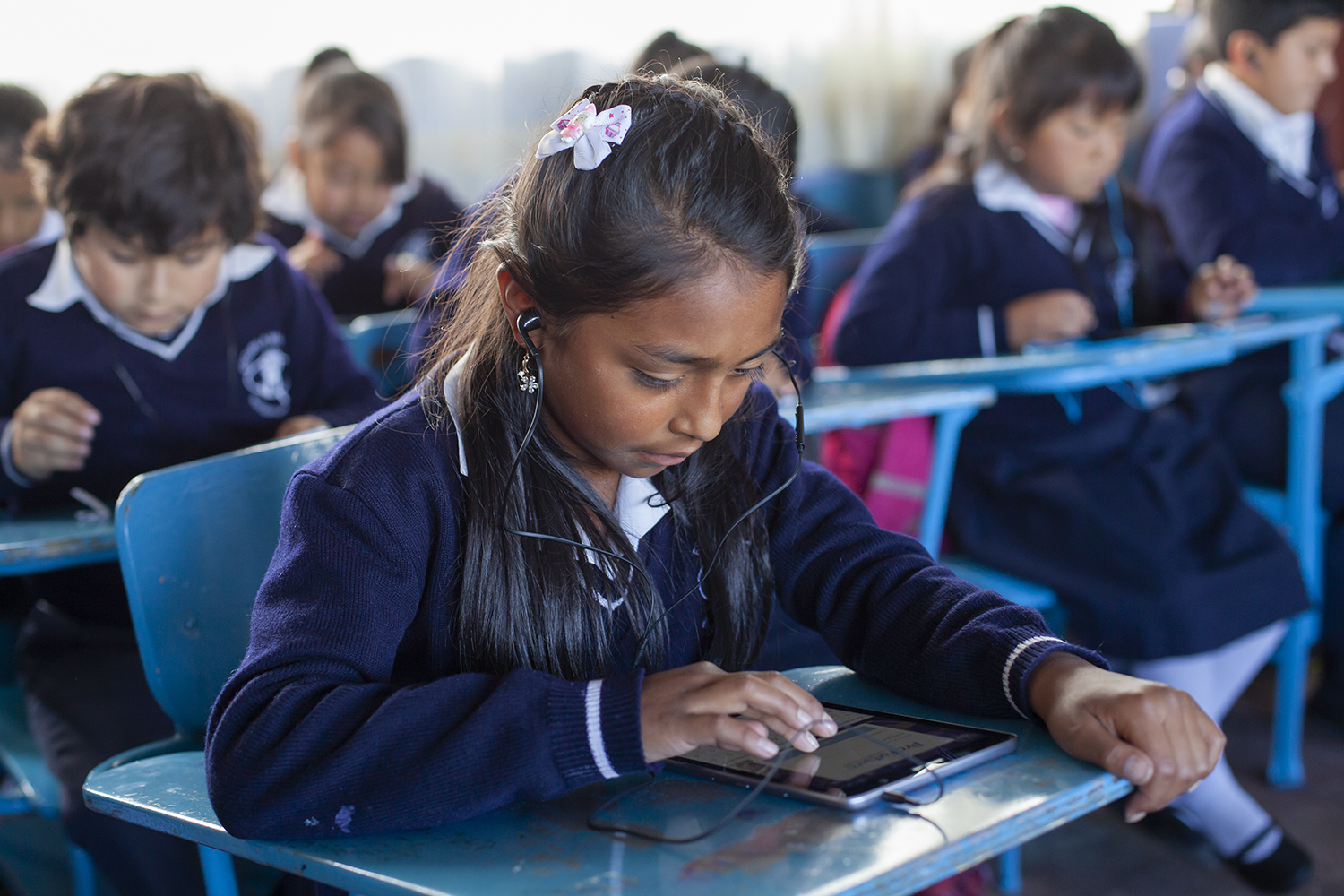In the current digital age, access to technology and use of the Internet form an integral part of everyday life, particularly for young people. However, as we know full well, although technology provides great opportunities and benefits, it also brings challenges and risks. Cyberbullying, misinformation, hate speech and radicalisation are some of the threats that girls, boys and young people face every time they use their mobile devices or the Internet.
Thus, according to the data provided by UNICEF, one in three young people aged between 13 and 24 claims to have suffered cyberbullying. The consequences of misinformation and fake news are also beginning to take their toll on the mental health of children, particularly girls, because, according to the data of the Plan International organisation, 46% of young and teenage girls feel depression, sadness, stress, worry or anxiety because of false information on the Internet. In addition, one in four question what they learn at school (with the risks that this entails for their education), more than half (55%) say they don’t know how to identify false content on the Internet and only 30% have received training in the educational field in this regard.
Within this context, digital resilience is emerging as a fundamental pillar of 21st-century education. Training young people to be responsible and confident digital citizens isn’t just an educational task, it’s also a social imperative. In this article we’ll examine how schools can implement effective strategies to foster digital resilience among their students and thus contribute to a safer and more promising digital future for the new generations.
One in three 13-24 year olds say they have experienced cyberbullying and 46% of girls and adolescents feel depression, stress and anxiety because of false information on the internet.
The concept of digital resilience and its components

Digital resilience refers to the ability of individuals to adapt and respond adaptively to challenges and threats in the digital environment. It involves having digital skills for browsing safely online. However, this quality goes far beyond technical skills. It also feeds on self-efficacy, in other words, unwavering confidence in the use of technology to defend oneself and others in the vast virtual universe. Finally, we have to be willing to seek help if we’re faced with digital threats (Lee & Hancock, 2023). We provide details of each of these components below.
Digital skills
Digital skills are essential in enabling young people to make safe and positive use of technology. As they begin to use digital devices from an early age, it’s essential for them to enhance their skills and digital literacy in a safe learning environment. Digital skills include the ability to search for and evaluate online information and communicate respectfully and safely on social media and protect privacy.
Educational interventions that focus on the development of digital skills have been shown to improve students’ ability to critically interact with online information and improve their well-being. Providing students with the skills required to effectively navigate the digital world will make them better equipped to overcome their challenges and protect themselves and others.
Sense of self-efficacy to defend oneself
In addition to possessing digital skills, it’s vital for young people to develop a sense of self-efficacy in relation to the use of technology in order to defend themselves and their peers. Self-efficacy refers to a person’s belief in his/her ability to exert control over his/her functioning and cope with events that affect his/her life.
Students with a high sense of self-efficacy are protected against the adverse effects of cyberbullying, given that they’re more likely to defend themselves and others. However, in addition to having a general sense of self-efficacy, it’s also important for students to feel confident in their ability to manage their experiences with the new technologies. In fact, these students are more likely to view the Internet as a functional tool that they can use to achieve their goals.
Positive intentions
In addition to standing up for themselves, it’s essential for young people to be willing to stand up for their peers facing digital challenges. Encouraging them to be “upstanders”, in other words, stepping in and helping people affected by difficult digital situations, will contribute to the collective well-being of their online and offline communities.
Seeking help
Although the goal of nurturing students’ digital skills and self-efficacy is to empower them to have the competence and sense of agency required to safely and confidently navigate the digital world on their own, they may still encounter difficult online situations, such as violations of privacy and cyberbullying. When this happens, young people are significantly less likely to seek help. Therefore, another fundamental aspect of digital resilience involves helping students to feel comfortable accessing support systems when they’re faced with difficult digital situations so that they don’t have to address these challenges alone.
Digital resilience refers to the ability of individuals to adapt and respond adaptively to challenges and threats in the digital environment.
How to promote digital resilience in schools
Digital resilience can be promoted in schools through educational interventions and programmes specifically designed to develop the skills, self-efficacy and help-seeking behaviours required for positive digital citizenship. We list some of the key strategies to achieve this below:
- Digital resilience curricula. Some organisations have developed specific digital resilience curricula that are integrated into schools to provide students with a comprehensive education on how to navigate the digital world and protect themselves in it. These curricula often address topics such as detecting misinformation, preventing cyberbullying, responsible use of social media and identifying hate speech. The programmes provide solid foundations for students when it comes to developing skills and confidence in the safe and positive use of technology.
- Teacher training. Teacher training is essential for the successful implementation of digital resilience programmes in schools. Educators need to be familiar with the digital challenges that students face and how to effectively and sensitively address these issues in the classroom. The teacher training may also include strategies to encourage open communication with students about their online experiences and how to provide support when it’s needed.
- Promoting open communication. This involves fostering an environment of open communication in schools where students feel safe to talk about their digital experiences and ask for help if it’s needed. This can be achieved through talks, workshops and group activities that standardise discussions about digital challenges.
- Workshops and interactive sessions. Workshops and interactive sessions constitute an effective way of teaching students specific digital resilience skills. These sessions may address topics such as identifying fake news, protecting online privacy, managing time on digital devices and responding to cyberbullying. Practical and participatory approaches allow students to acquire practical skills and reflect on their online behaviour.
- Collaboration with technology experts. Collaboration with technology experts and organisations devoted to online security can enrich digital resilience programmes. These associations can provide resources, updated educational materials and technological tools to enhance the students’ learning experience. They can also offer deeper insights into the latest trends in digital risks and strategies in order to deal with them.
- Focus on digital citizenship. Digital resilience programmes also focus on promoting responsible digital citizenship. This involves not only teaching students how to protect themselves, but also how to be ethical and compassionate digital citizens who protect and support their peers online. The emphasis on empathy, understanding different standpoints and respect for others is essential in this training.
- Evaluation and monitoring. It’s essential to evaluate the effectiveness of digital resilience programmes in order to ensure that they’re having a positive impact on students. The evaluations can be carried out through surveys, interviews and observations to measure the changes in the students’ knowledge, attitudes and online behaviour. Ongoing monitoring means that the programmes can be adjusted and improved in keeping with needs and the results obtained.
Pioneers in public policies
As for the implementation of public policies to promote digital resilience in schools, there are public administrations in several countries that have already taken measures. Although the approaches vary in each country, depending on their specific needs and contexts, most of them include several of the elements listed in the previous section. We review some of the countries and their programmes below.
- The United Kingdom has been a leader in promoting digital resilience in schools. It’s developed educational programmes such as Thinkuknow, which provides resources for teachers, parents and students on online safety and preventing cyberbullying.
- In the United States, the government has promoted digital resilience education through initiatives such as NetSmartz Workshop and Common Sense Media, which offer materials and resources for schools and families in order to address online safety and digital citizenship issues.
- The Australian Government has put in place programmes such as the eSafety Commissioner, which focuses on online safety for children and young people, and the Office of the eSafety Commissioner, which provides resources and support for schools.
- Canada has implemented educational programmes on digital resilience such as MediaSmarts, which provides resources and tools for digital media education.
- Singapore has implemented digital resilience policies in schools, focusing on teaching digital skills and ethics for responsible digital citizenship.
- Finland has been acknowledged for its innovative approach to digital education and digital citizenship. It’s implemented several programmes that encourage the responsible and safe use of technology in schools.
Research on the effectiveness of public policies and programmes designed to build digital resilience in schools is showing promising results.
What does the evidence say?
Evidence on the effectiveness of the public policies and programmes designed to develop digital resilience in schools is an area of research that continues to grow. In general, the research is showing promising results, although it’s important to note that the effectiveness of these policies may vary, depending on various factors such as the duration and the specific context of each programme.
For example, the Digital Resilience Pilot, a Dutch collaborative initiative involving the Institute for Strategic Dialogue (ISD) and Codename Future, provides an excellent example of how to foster digital resilience in schools. Through a digital resilience curriculum, the project trained teachers to impart knowledge and skills to students aged 16-19 on how to deal with online challenges such as grooming, radicalisation and misinformation. The evaluation of the programme demonstrated a significant positive impact on the students, including an increase in their sense of responsibility towards the well-being of people on social media, greater knowledge of critical issues involving safe use of the Internet and greater confidence in the handling of challenging online situations (Reynolds & Parker, 2018).
Another intervention was administered in 566 primary schools in the United Kingdom. This study (Lee & Hancock, 2023) showed how the intervention improved digital skills, self-efficacy with technology, intentions to become a defender of others and willingness to ask for help when it’s needed.
Helping young people to manage their digital experiences is particularly important, as access to devices and the use of social media is starting earlier and earlier. Parents are sometimes not sufficiently prepared to teach their children to operate responsibly in the digital environment. Therefore, educational interventions that bring lessons on digital safety and resilience into the classroom may be a promising path to support children of diverse backgrounds as they maximise the benefits and minimise the risks of using social technology (Lee & Hancock, 2023).
Collaboration between organisations, educational institutions and digital resilience experts is key to developing effective programmes that address online challenges and promote positive digital citizenship. By adopting research-based approaches and regularly evaluating the results, we can ensure that our interventions are effective and that they have a lasting impact on the lives of young people. Digital resilience is a crucial pillar for the well-being and success of future generations in the ever-evolving digital world.
References
Lee, A.Y. & Hancock, J.T. 2023. Developing digital resilience: An educational intervention improves elementary students’ response to digital challenges. Computers & Education. Volume 5.
Reynolds, L., & Parker, L. (2018). Digital resilience:Stronger citizens online. Institute for Strategic Dialogue: London, UK.






